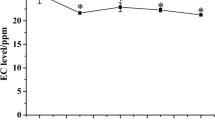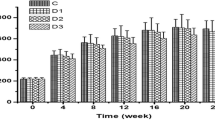Abstract
There has been growing public concern regarding exposure to microwave fields as a potential human health hazard. This study aimed to identify sensitive biochemical indexes for the detection of injury induced by microwave exposure. Male Wistar rats were exposed to microwaves for 6 min per day, 5 days per week over a period of 1 month at an average power density of 5 mW/cm2 (specific absorption rate of 2.1 W/kg). Urine specimens were collected over 24 h in metabolic cages at 7 days, 21 days, 2 months, and 6 months after exposure. 1H NMR spectroscopy data were analyzed using multivariate statistical techniques. Urine metabolic profiles of rats after long-term microwave exposure were significantly differentiated from those of sham-treated controls using principal component analysis or partial least squares discriminant analysis. Significant differences in low molecular weight metabolites (acetate, succinate, citrate, ketoglutarate, glucose, taurine, phenylalanine, tyrosine, and hippurate) were identified in the 5 mW/cm2 microwave exposure group compared with the sham-treated controls at 7 days, 21 days, and 2 months. Metabolites returned to normal levels by 6 months after exposure. These data indicated that these metabolites were related to the perturbations of energy metabolism particularly in the tricarboxylic acid cycle, and the metabolism of amino acids, monoamines, and choline in urine represent potential indexes for the detection of injury induced by long-term microwave exposure.



Similar content being viewed by others
Abbreviations
- DMG:
-
dimethylglycine
- NMR:
-
nuclear magnetic resonance
- PCA:
-
principal component analysis
- PLS-DA:
-
partial least squares discriminant analysis
- PR:
-
pattern recognition
- TCA:
-
tricarboxylic acid
- TMAO:
-
trimethylamine N-oxide
References
Finnie JW, Cai Z, Blumbergs PC et al (2006) Expression of the immediate early gene, c-fos, in fetal brain after whole of gestation exposure of pregnant mice to global system for mobile communication microwaves. Pathology 38(4):333–335
Frey AH (2002) Hold the (cell) phone... Science 295(5554):440–441
Smith P, Kuster N, Ebert S et al (2007) GSM and DCS wireless communication signals: combined chronic toxicity/carcinogenicity study in the Wistar rat. Radiat Res 168(4):480–492
Paulraj R, Behari J (2006) Protein kinase C activity in developing rat brain cells exposed to 2.45 GHz radiation. Electromagn Biol Med 25(1):61–70
Xu S, Ning W, Xu Z et al (2006) Chronic exposure to GSM 1800-MHz microwaves reduces excitatory synaptic activity in cultured hippocampal neurons. Neurosci Lett 398(3):253–257
Tillmann T, Ernst H, Ebert S et al (2007) Carcinogenicity study of GSM and DCS wireless communication signals in B6C3F1 mice. Bioelectromagnetics 28(3):173–187
Idle JR, Gonzalez FJ (2007) Metabolomics. Cell Metab 6(5):348–351
Xu EY, Schaefer WH, Xu Q (2009) Metabolomics in pharmaceutical research and development: metabolites, mechanisms and pathways. Curr Opin Drug Discov Dev 12(1):40–52
Gu HW, Pan ZZ, Duda C et al (2007) 1H NMR study of the effects of sample contamination in the metabolomic analysis of mouse urine. J Pharm Biomed Anal 45(1):134–140
Katajamaa M, Oresic M (2007) Data processing for mass spectrometry-based metabolomics. J Chromatogr 1158(1–2):318–328
Barker M, Rayens W (2003) Partial least squares for discrimination. J Chemometr 17:166–173
Srivastava S, Roy R, Singh S et al (2010) Taurine – a possible fingerprint biomarker in non-muscle invasive bladder cancer: a pilot study by 1H NMR spectroscopy. Cancer Biomark 6(1):11–20
Zhang SC, Nagana Gowda GA, Asiago V et al (2008) Correlative and quantitative 1H NMR-based metabolomics reveals specific metabolic pathway disturbances in diabetic rats. Anal Bio Chem 383(1):76–84
Oldiges M, Lütz S, Pflug S et al (2007) Metabolomics: current state and evolving methodologies and tools. Appl Microbiol Biotechnol 76(3):495–511
Beger RD, Hansen DK, Schnackenberg LK et al (2009) Single valproic acid treatment inhibits glycogen and RNA ribose turnover while disrupting glucose-derived cholesterol synthesis in liver as revealed by the [U-C(6)]-d-glucose tracer in mice. Metabolomics 5(3):336–345
Solanky KS, Bailey NJ, Beckwith-Hall BM et al (2003) Application of biofluid 1H nuclear magnetic resonance-based metabonomic techniques for the analysis of the biochemical effects of dietary isoflavones on human plasma profile. Anal Biochem 323(2):197–204
Kim SH, Yang SO, Kim HS et al (2009) 1H-nuclear magnetic resonance spectroscopy-based metabolic assessment in a rat model of obesity induced by a high-fat diet. Anal Bioanal Chem 395(4):1117–1124
Enea C, Seguin F, Petitpas-Mulliez J et al (2010) 1H NMR-based metabolomics approach for exploring urinary metabolome modifications after acute and chronic physical exercise. Anal Bioanal Chem 396(3):1167–1176
Coolen SA, Daykin CA, van Duynhoven JP et al (2008) Measurement of ischaemia-reperfusion in patients with intermittent claudication using NMR-based metabonomics. NMR Biomed 21(7):686–695
Slupsky CM, Cheypesh A, Chao DV et al (2009) Streptococcus pneumoniae and Staphylococcus aureus pneumonia induce distinct metabolic responses. J Proteome Res 8(6):3029–3036
Wei L, Liao PQ, Wu HF et al (2008) Toxicological effects of cinnabar in rats by NMR-based metabolic profiling of urine and serum. Toxicol Appl Pharmacol 227(3):417–429
Wyss M, Kaddurah-Daouk R (2000) Creatine and creatinine metabolism. Physiol Rev 80(3):1107–1213
Wang YL, Tang HR, Nicholson JK et al (2005) A metabonomic strategy for the detection of the metabolic effects of chamomile (Matricaria recutita L.) ingestion. J Agric Food Chem 53(2):191–196
Schlattner U, Tokarska-Schlattner M, Wallimann T (2006) Mitochondrial creatine kinase in human health and disease. Biochim Biophys Acta Bioenerg 1762(2):164–180
Waterfield CJ, Turton JA, Scales MD et al (1993) Effect of various non-hepatotoxic compounds on urinary and liver taurine levels in rats. Arch Toxicol 67(8):538–546
Tyburski JB, Patterson AD, Krausz KW et al (2008) Radiation metabolomics: identification of minimally invasive urine biomarkers for gamma-radiation exposure in mice. Radiat Res 170(1):1–14
McGregor DO, Dellow WJ, Lever M et al (2001) Dimethylglycine accumulates in uremia and predicts elevated plasma homocysteine concentrations. Kidney Int 59(6):2267–2272
Wei L, Liao PQ, Wu HF et al (2009) Metabolic profiling studies on the toxicological effects of realgar in rats by 1H NMR spectroscopy. Toxicol Appl Pharmacol 234(4):314–325
Zhao L, Peng RY, Gao YB et al (2011) Influence of microwave radiation on transmitters of blood plasma and metabolic enzymes in serum of macaque. Mil Med Sci 35(5):361–364
Delaney J, Neville WA, Swain A et al (2004) Phenylacetylglycine, a putative biomarker of phospholipidosis: its origins and relevance to phospholipid accumulation using amiodarone treated rats as a model. Biomarkers 9(3):271–290
Kasuya F, Yamaoka Y, Osawa E et al (2000) Difference of the liver and kidney in glycine conjugation of ortho-substituted benzoic acids. Chem Biol Interact 125(1):39–50
Nicholls AW, Mortishire-Smith RJ, Nicholson JK (2003) NMR spectroscopic-based metabonomic studies of urinary metabolite variation in acclimatizing germ-free rats. Chem Res Toxicol 16(11):1395–1404
Park JC, Hong YS, Kim YJ et al (2009) A metabonomic study on the biochemical effects of doxorubicin in rats using (1)H-NMR spectroscopy. J Toxicol Environ Health 72(6):374–384
Effelsberg NM, Hügle T, Walker UA (2010) A metabolic cause of spinal deformity. Metabolism 59(1):140–143
Phornphutkul C, Introne WJ, Perry MB et al (2002) Natural history of alkaptonuria. N Engl J Med 347(1):2111–2121
Li ZF, Wang J, Huang C et al (2010) Gas chromatography/time-of-flight mass spectrometry-based metabonomics of hepatocarcinoma in rats with lung metastasis: elucidation of the metabolic characteristics of hepatocarcinoma at formation and metastasis. Rapid Commun Mass Spectrom 24(18):2765–2775
Holmes E, Foxall PJ, Spraul M et al (1997) 750 MHz 1H NMR spectroscopy characterisation of the complex metabolic pattern of urine from patients with inborn errors of metabolism: 2-hydroxyglutaric aciduria and maple syrup urine disease. J Pharm Biomed Anal 15(11):1647–1659
Wang LF, Hu XJ, Peng RY et al (2010) Influence of long-term microwave radiation on the contents of amino acids and monoamines in urines in Wistar rats. Chin J Hyg Occup Dis 28(6):445–448
Acknowledgments
We are grateful to Xianzhong Yan and Bo Sun (National Center of Biomedical Analysis) for their kind help with metabolomics technology. This work was supported by the National Basic Research Program of China (2011CB503706) and the National Natural Science Foundation of China (30970871).
Conflicts of interest
The authors declare that they have no competing interests.
Author information
Authors and Affiliations
Corresponding authors
Rights and permissions
About this article
Cite this article
Wang, LF., Hu, XJ., Peng, RY. et al. Application of 1H-NMR-based metabolomics for detecting injury induced by long-term microwave exposure in Wistar rats’ urine. Anal Bioanal Chem 404, 69–78 (2012). https://doi.org/10.1007/s00216-012-6115-3
Received:
Revised:
Accepted:
Published:
Issue Date:
DOI: https://doi.org/10.1007/s00216-012-6115-3




